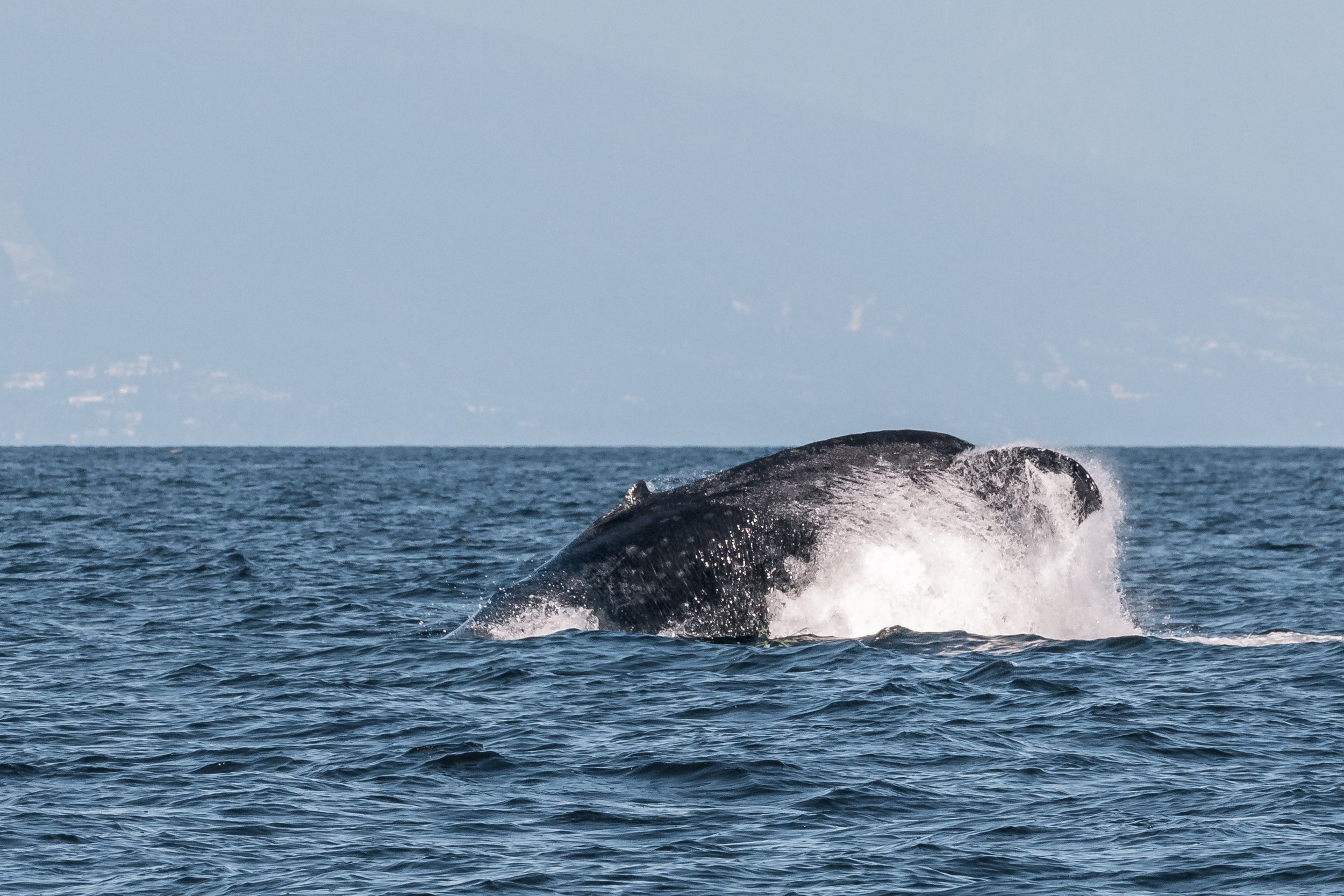July 23rd - Smoke on the water
On Saturday the 23rd we made our way out of the harbour towards a humpback that was seen off Thrasher rock near the south end of Gabriola Island. By the time we reached this whale, they had already travelled north of the Flat top islands. This little whale was in a hurry to get somewhere! Humpbacks typically travel slowly when we watch them, usually around 2-7 km an hour, however, this young whale seemed to be moving at about 10 km an hour! As we settled in to see who this whale was and where they were going they slowed for a brief moment, disappeared under the waves and surfaced quickly for a breach! No one was quite ready or expecting it so we weren’t able to get photos of it.
Humpbacks often breach multiple times in a row, but why? Our leading theories are that they are communicating over long distances with other whales, knocking parasites off their bodies, or displaying excitement. Was this little whale sending an alert to someone we couldn’t see? Maybe they were calling out to let others know they were on their way!
After the breach, we waited patiently and were treated to a different type of behaviour - a cartwheel! Cartwheels are when whales throw their tail out of the water in a large arch motion. They then proceeded to tail slap 7 times! Thanks to this cartwheel and tail slap we were able to see the fluke from this young whale and ID them as Smoke!
Smoke is an interesting whale that we are very excited to see again in our waters this year. Smoke first appeared in our waters with their fluke sporting many small white flecks and a few spots. At the time we couldn’t match this yearling to any whales in our catalogue, but we figured with time we would be able to ID them as a previous calf in our range.
A few weeks after spotting them the first time we saw them again, only we didn’t realize it was the same whale. During the second encounter, this young whale had a large white and orange burst mark taking up almost a quarter of their tail! The wound looked fairly fresh, but we couldn’t figure out what would make a scar like that. Aside from that new wound, the young whale seemed happy and healthy. We named this little one “Scorch” for the large burn-like make and continued to keep our eyes out for them for the rest of our 2021 season.
It wasn’t until early this year that we finally figured out who our whale was. While scrolling through Happy Whale we came across a photo that looked very familiar, it was Scorch! According to Happy Whale, Scorch is actually named Smoke and was born in 2020 to a female humpback named Flame. Flame is an Alaskan humpback! She travels from her breeding grounds in Hawaii to the feeding grounds in Juneau Alaska every year. Smoke was likely born in Hawaii in 2020 and travelled to Juneau with their mom in the summer to learn where the feeding grounds are and how to forage properly after they separate from their mom. Humpbacks show incredible site fidelity, which means they return to the same breeding and feeding grounds year after year.
So why is Smoke here? Thousands of humpbacks travel past the Washington and BC coastline every year as they migrate north to the feeding grounds. Many stop off Washington, some hang out in the Salish Sea all summer, but most will head for northern BC and Alaska. Smoke likely began his first solo migration with the intent of getting to Alaska but stopped in the Salish Sea for a break. Humpbacks rely on fat stores they build up in the summers to get them through to the next feeding seasons, so Smoke was probably running a bit empty and decided to stop for a snack in the Salish Sea. We will never know if their stop here was supposed to be temporary or the reason they stayed, but Smoke seemed to make friends last summer. They were seen a few times hanging out with other yearling and juvenile humpbacks in the area throughout the summer. They have returned again this year and have already been spotted with some of the same whales they were with last year. Smoke could have also realized that there was enough food here and there is no reason to go all the way back to Alaska for the summers. Regardless of the reason, we are happy to have them splashing around the Salish Sea again and hope to continue to see him for many years to come.
Enjoy the pictures of Smoke and the wildlife taken during our tour today by marine naturalists Rebeka Pirker and Carmen Murphy.
Photo by Rebeka Pirker, 10:30.
Photo by Rebeka Pirker, 10:30.
Photo by Rebeka Pirker, 10:30.
Photo by Rebeka Pirker, 10:30.
Photo by Rebeka Pirker, 10:30.
Photo by Rebeka Pirker, 10:30.
Photo by Rebeka Pirker, 10:30.
Photo by Rebeka Pirker, 3:30.
Photo by Rebeka Pirker, 3:30.
Photo by Rebeka Pirker, 3:30.
Photo by Rebeka Pirker, 3:30.
Photo by Rebeka Pirker, 3:30.
Photo by Rebeka Pirker, 3:30.
Photo by Rebeka Pirker, 3:30.
Photo by Rebeka Pirker, 3:30.
Photo by Rebeka Pirker, 3:30.
Photo by Rebeka Pirker, 3:30.
Photo by Rebeka Pirker, 3:30.
Photo by Rebeka Pirker, 3:30.
Photo by Rebeka Pirker, 3:30.
Photo by Rebeka Pirker, 3:30.
Photo by Rebeka Pirker, 3:30.
Photo by Rebeka Pirker, 3:30.
Photo by Rebeka Pirker, 3:30.
Photo by Rebeka Pirker, 3:30.
Photo by Rebeka Pirker, 3:30.


























